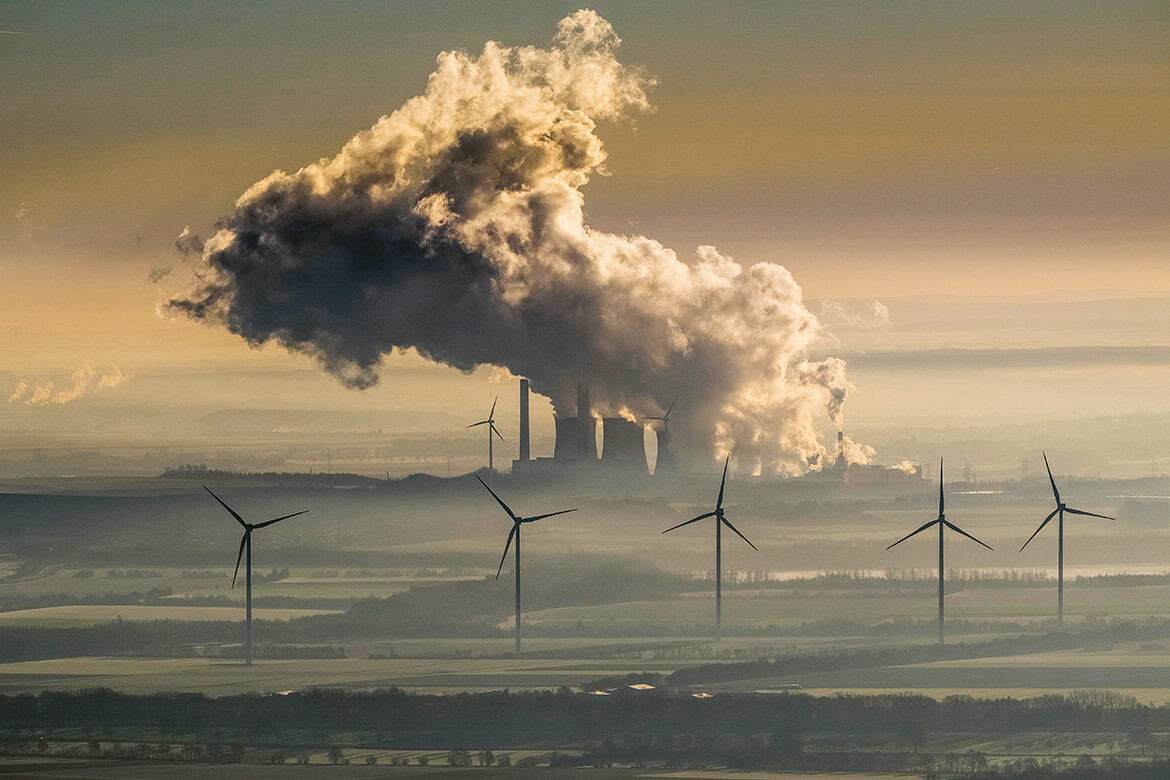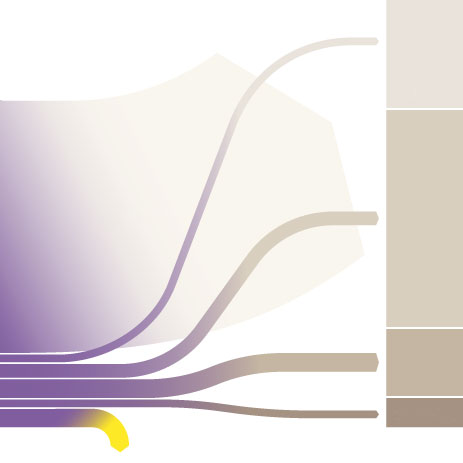Brother Sun and Sister Coal
Electricity from renewable sources is paradoxically leading to higher CO2 emissions. Measures must be taken in the market to ensure that coal-fired power plants aren’t being funded by mistake.

Coal-fired power plants have to pay for the environmental damage they do. Otherwise, even cheap wind turbines won’t push them out of the market. | Image: Keystone/imageBROKER/Hans Blossey
The ‘energy turnaround’ could really be speeding up in Europe. Wind turbines and photovoltaic power plants are currently producing the cheapest electricity. Their running costs are lower than conventional power plants. In 2018 Germany was able to produce more than 40 percent of its energy needs from renewable sources for the first time, according to the calculations of researchers at the Fraunhofer Institute for Solar Energy Systems ISE in Freiburg im Breisgau.
That sounds good at first. But when you look closer, there are problems. Wind and solar energy are only available some of the time, so to achieve a stable grid we still need flexible power plants that can produce electricity very quickly when necessary. Apart from nuclear power, the only climate-friendly technologies available are hydroelectric and pumped storage power plants – but progress on expanding these is sluggish. So conventional power plants still have to be ready to cover the remaining energy demand. And in many countries today, that means keeping the dirty, coal-fired power plants running.
The reason for this lies in the economic structure of the electricity market. “We’re currently in a transition phase from the old, regulated structures to a new, market-dominated world”, explains Hannes Weigt, an economist at the University of Basel who is also involved in the National Research Programme ‘Energy Turnaround’ (NRP 70). If the market were highly regulated, governments could in future put a greater emphasis on clean energy sources for flexible power plants. But investments are stagnating, and energy providers are hesitant, because existing plants are often not very cost-effective. The owners of hydroelectric and pumped storage plants in Switzerland, for example, are complaining about deteriorating economic circumstances.
Costs trump efficiency
Ironically, it’s renewable energy sources that have helped to create this complicated situation. To explain this, we have to take a closer look at the energy market. It’s like the stock market: the price of electricity on the electricity exchange is determined by short-term, supply-and-demand curves. The price is set for everyone by the power plant that covers the remaining demand. As the amount of cheap electricity available from wind turbines and photovoltaic power plants increases, it pushes out the most expensive power plants from the market. This first affects oil power plants, then gas turbines, which are the next-most expensive.
It’s the coal-fired power plants that then remain. Since the price of coal and emissions certificates has dropped in recent years, they provide cheaper electricity than gas turbines, which are more efficient but also more expensive. Modern plants such as the gas power plants Irsching 4 and 5 in southern Germany are only used as a ‘cold reserve’, despite their extremely high degree of efficiency. In other words, they have been all but shut down. Even Switzerland’s hydropower plants were unprofitable for several years. The reason for this is the expansion of wind power in northern Europe.
“The situation is paradoxical”, says Philippe Jacquod of the Institute of Systems Engineering at the University of Applied Sciences and Arts Western Switzerland Valais (HES-SO). He says that sinking electricity prices are currently scaring off investors from investing further in renewable energies, power lines and the storage facilities necessary for grid stability. In order to understand how we might better manage the transition from fossil fuels to climate-friendly technologies, Jaquod and his colleague Laurent Pagnier are using a new technological/economic model to look for solutions relevant to the European electricity market. Switzerland is an important transit country on the north-south route for electricity.
Jaquod and Pagnier depict the European electricity grid as a network in which every country comprises one or two nodes according to its size. Neighbouring country nodes are linked to each other by a kind of electricity motorway. Each node contains important information on the country in which it is situated, its electricity generation capacity and electricity usage; these figures are precise down to the hour, and are provided by the Association of European Transmission System Operators (ETSO).
Their model links the development of production capacity with the price on the electricity exchange. It shows that the production revenue of the electricity providers depends very much on the provision for the remaining energy demand. As stated above, this remaining energy is often provided by coal-fired power plants across Europe at precisely the time when they are supplying it uneconomically at short notice. Researchers call this a ‘must-run’ situation. In other words, it’s economically disadvantageous to take these coal-fired plants off the grid, shut them down, and then fire them up again. As a result, they are kept running, even though they have to offer electricity at short notice at less than the cost price. “This ‘must-run’ capacity urgently has to be reduced”, says Jaquod.
“Coal is too cheap. We should be putting a tax of at least EUR 40 to 50 on every tonne of CO2”, says Jaquod. He believes this is the only way to overcome the paradox at the heart of the energy turnaround. It’s not about “taxes for the sake of taxes”, he insists. It’s about making coal-fired power plants pay for the impact they have on the environment. The good news for end-users is that electricity would only increase in price a few pennies per kilowatt hour.
The Denmark/Norway model
Economic interventions like this in the European electricity market could certainly be sensible in the transitional phase. This opinion is shared by the economist Hannes Weigt. The long-term profitability that is so important to electricity providers depends in part on the average electricity price and on the offers of competitors – in other words, it depends on the overall energy mix of a country. But it is also influenced by political issues such as taxes and funding models. Studies have shown that it would be ideal if the ‘real prices’ of individual energy sources could be calculated as quickly as possible. “If we were to apply the actual costs of coal and gas, then renewable energies would probably already be competitive, even without state support”, says Weigt.
Weigt has also presented models for the Swiss energy mix. The Swiss 2050 energy strategy intends to achieve a considerable increase in photovoltaic power. Together with imports, this should gradually replace the electricity provided from Switzerland’s five nuclear power stations from 2035 onwards. This will entail a fundamental shift. Instead of five large power plants, many thousands of photovoltaic units will have to be installed on private buildings and coordinated with each other. Pumped storage plants or newly developed storage facilities could ensure the stability of the grid. “In the long term, hydropower and renewable energies are natural partners”, adds Jacquod.
Norway and Denmark provide ample proof that mustering the courage to embark on a swift energy transition can be worthwhile – and not just for the environment. Denmark already provides much of its power from wind energy – more than 40 percent of its capacity – and stability is provided by electricity from pumped storage plants in the Norwegian mountains. Norway’s lakes could in future become Europe’s principal electricity storage site. What’s more, neither Norway nor Denmark has seen any noticeable rise in energy prices.




